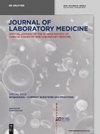液体活检的多模式性:组合是否揭示了在单个血液分析物中无法检测到的见解?
IF 1.8
4区 医学
Q4 MEDICAL LABORATORY TECHNOLOGY
引用次数: 3
摘要
摘要每个肿瘤学疾病的异质性可以通过简单的实时抽血的分子分析来反映。液体活检检测已被证明可用于癌症检测、最小残留疾病的证明、治疗决策和监测。然而,单个血液分析物并不能全面反映疾病。最近的研究表明,多模式/多参数/多分析物液体活检测试具有生成疾病复杂性的高分辨率快照的优势。不同的血液分析物,如循环肿瘤细胞、循环免疫细胞、肿瘤培养的血小板、细胞外小泡、无细胞DNA、无细胞RNA和循环蛋白相互补充,对临床癌症管理具有附加价值。在这里,我们想回顾导致这些有希望的结论的研究,并在最后提到,在转化为临床之前,还有许多挑战,包括临床实用性、方法标准化、成本报销和数据管理等问题。本文章由计算机程序翻译,如有差异,请以英文原文为准。
Multimodality in liquid biopsy: does a combination uncover insights undetectable in individual blood analytes?
Abstract The heterogeneity of each individual oncologic disease can be mirrored by molecular analysis of a simple blood draw in real time. Liquid biopsy testing has been shown useable for cancer detection, proof of minimal residual disease, therapy decision making and monitoring. However, an individual blood analyte does not present a comprehensive picture of the disease. It was recently shown that multi-modal/multi-parametric/multi-analyte liquid biopsy testing has the advantage of generating a high-resolution snapshot of the disease complexity. The different blood analytes such as circulating tumor cells, circulating immune cells, tumor-educated platelets, extracellular vesicles, cell-free DNA, cell-free RNA and circulating proteins complement each other and have additive value for clinical cancer management. We, here, like to review the studies leading to these promising conclusions and like to, at the end, mention that many challenges lie ahead before the translation into the clinic can be accomplished, including issues concerning clinical utility, method standardization, cost reimbursement and data management.
求助全文
通过发布文献求助,成功后即可免费获取论文全文。
去求助
来源期刊

Journal of Laboratory Medicine
Mathematics-Discrete Mathematics and Combinatorics
CiteScore
2.50
自引率
0.00%
发文量
39
审稿时长
10 weeks
期刊介绍:
The Journal of Laboratory Medicine (JLM) is a bi-monthly published journal that reports on the latest developments in laboratory medicine. Particular focus is placed on the diagnostic aspects of the clinical laboratory, although technical, regulatory, and educational topics are equally covered. The Journal specializes in the publication of high-standard, competent and timely review articles on clinical, methodological and pathogenic aspects of modern laboratory diagnostics. These reviews are critically reviewed by expert reviewers and JLM’s Associate Editors who are specialists in the various subdisciplines of laboratory medicine. In addition, JLM publishes original research articles, case reports, point/counterpoint articles and letters to the editor, all of which are peer reviewed by at least two experts in the field.
 求助内容:
求助内容: 应助结果提醒方式:
应助结果提醒方式:


